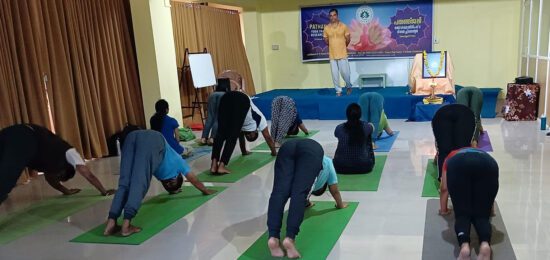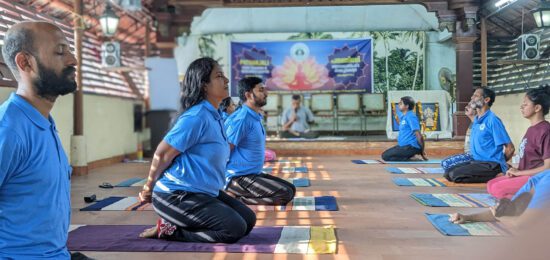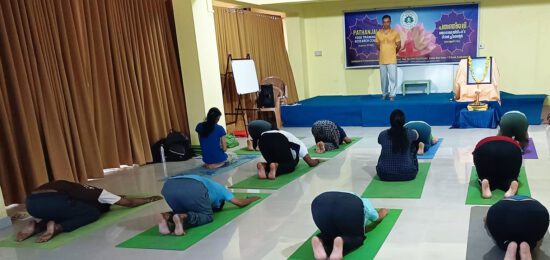Yoga offers a range of techniques that can effectively reduce stress and its negative effects on the body and mind.
Here are some yogic techniques known for their stress-reducing benefits:

Asanas (Yoga Poses):
Practicing yoga asanas helps release physical tension, promotes relaxation, and increases body awareness. Certain asanas, such as Child’s Pose (Balasana), Corpse Pose (Savasana), and Forward Fold (Uttanasana), are particularly beneficial for calming the mind and reducing stress.
Pranayama (Breathing Exercises):
Deep breathing exercises have a profound impact on the nervous system, promoting relaxation and reducing stress. Techniques like Alternate Nostril Breathing (Nadi Shodhana), Complete Breath (Sampoorna Vyayama Pranayama), and Deep Belly Breathing (Diaphragmatic Breathing) can be practiced to calm the mind and reduce stress levels.
Meditation:
Regular meditation practice helps quiet the mind, increase mindfulness, and reduce stress. Mindfulness meditation, Loving-Kindness meditation, and Transcendental Meditation are some popular techniques that promote relaxation and overall well-being.
Yoga Nidra:
Also known as “yogic sleep,” Yoga Nidra is a guided relaxation technique that induces deep relaxation and reduces stress. By systematically relaxing different parts of the body and focusing on breath awareness, Yoga Nidra promotes physical, mental, and emotional relaxation.
Mantra Chanting:
Repetition of calming and soothing mantras can help redirect the mind’s focus and induce a state of relaxation. Chanting mantras like “Om” or other Sanskrit chants can be practiced to reduce stress and promote a sense of peace.
Mindful Movement:
Engaging in mindful movement practices such as walking meditation or slow, deliberate yoga flows encourages the integration of mind and body. By staying present and focused on the sensations of movement, stress levels can be reduced and a sense of inner calm can be cultivated.
Lifestyle and Diet:
In addition to the above techniques, adopting a yogic lifestyle that includes a balanced diet, adequate rest, and positive social interactions contributes to overall stress reduction. A wholesome, vegetarian or plant-based diet, sufficient sleep, and maintaining healthy relationships support the body and mind in managing stress more effectively.
It’s important to note that consistent practice and finding what works best for individual needs and preferences are key when using yogic techniques for stress reduction. It is recommended to learn from a qualified yoga instructor to ensure proper guidance and to modify the practices according to one’s physical abilities and limitations. Yoga and meditation have been found to increase the GABAergic tone by activating the prefrontal cortex (PFC) region. The PFC, in turn, activates the reticular nucleus of the thalamus (RE), which is responsible for producing GABA. This mechanism allows meditators to achieve a higher level of cognition, concentration, and alertness, as these functions are controlled by the PFC.
Regular practice of yoga and meditation facilitates the connection between the mind and body through a series of postures and breathing exercises. By emphasizing a longer exhalation compared to the inhalation, the sympathetic nervous system’s activity increases, leading to instant stress reduction. The benefits of yoga include a decrease in stress and tension, increased muscle strength, balance, and flexibility, as well as a reduction in blood pressure, noradrenaline, and cortisol levels. Moreover, regular yoga practice has been shown to improve depression by significantly increasing serotonin (5-hydroxytryptamine or 5-HT) levels at nerve synapses, resulting in an uplifted mood. Additionally, yoga reduces the levels of monoamine oxidase (MAO), an enzyme responsible for breaking down neurotransmitters and cortisol. As a result, yoga and meditation serve as preventive medicine and are highly recommended for everyone, not just individuals suffering from specific diseases. A study conducted by Kinsley Kumar et al. examined the effect of yoga and meditation on serum cortisol levels
in first-year medical students. The results showed a 4.8% decrease in morning serum cortisol levels in the yoga group (572.18±168.03 to 544.98±139.89), while the control group experienced a 3.4% increase (558.89±162.69 to 577.26±254.5). Serum cortisol level is considered a marker of stress and inflammation, with higher levels indicating higher stress levels [59].
Another study by Heinekens MR assessed the effect of yoga on the level of salivary cortisol in nursing students. The findings revealed a significant decrease in post-asana salivary cortisol levels compared to pre-asana levels [60]. Salivary cortisol level serves as an indicator of stress. Additionally, a short-term integrative body-mind training (IBMT), a form of meditation lasting 30 minutes per day for five days, was found to significantly enhance cerebral blood flow (CBF) in the left subequal /adjacent ventral anterior cingulate cortex (ACC), medial prefrontal cortex (mPFC), and insula. This improvement in CBF resulted in positive mood enhancement and neuroplasticity, leading to improved attention and self-regulation. The left ACC and insula are critical brain areas involved in self-regulation.
Yoga and meditation provide an additional energy boost to neurons and glial cells by enhancing capillary vesiculation. This process expands the neuropil, which includes neurons, glial cells, and capillaries, ultimately leading to thickening of the cortex.
It is worth noting that adhering to the five ‘P’s in our lives can help prevent stress and its associated ailments. These five ‘P’s include maintaining a Proper Diet, engaging in Proper Exercise, practicing Proper Breathing, cultivating Positive
Thinking, and ensuring Proper Relaxation. By focusing on these aspects, we can establish a foundation for a healthy lifestyle, reduce stress levels, and promote overall well-being. Paying attention to our dietary choices, engaging in regular physical activity, adopting mindful breathing techniques, nurturing positive thoughts and attitudes, and prioritizing relaxation are essential components of a balanced approach to stress management and maintaining optimal health and wellbeing.
References :
- Elliot GR, Eisdorfer C. Stress and Human Health: An Analysis and Implications of Research. A study conducted by the Institute of Medicine, National Academy of Sciences. Springer Publishing, New York, 1982, pp. 11-24.
- Harry M, Natalie R, Mark D. Types of Stressors (Eustress vs. Distress). Stress Reduction and Management. Retrieved from www.cascadementalhealth.org.
- McEven BS. Neurobiological and Systemic Effects of Chronic Stress. Chronic Stress (Thousand Oaks), April 2017; 1.
- Dumen RS. Neural Plasticity: Consequences of Stress and Actions of Antidepressant Treatment. Dialogues in Clinical Neuroscience, 2004; 6(2): 157-169.
- Neurotransmitters That Help Control Unwanted Thoughts. Cognitive Neuroscience Society. Retrieved from https://www.cogneurosociety.org (last accessed: 26.06.2020).
- De Kloet ER, Joels M, Holsbo..Yoga Psychology, Swami Abhedananda Ramakrishna Vetanta Math.
- Prana and Pranayama, Swami Nirnajananada SaraswatiPractical Yoga Psychology, Dr. Rishi Vivekananda , Yoga Publication Trust
- Yoga and Meditation, Swami Vivekananda published Ramakrishna Math.
Post by: Dr. A. Radhakrishnan





